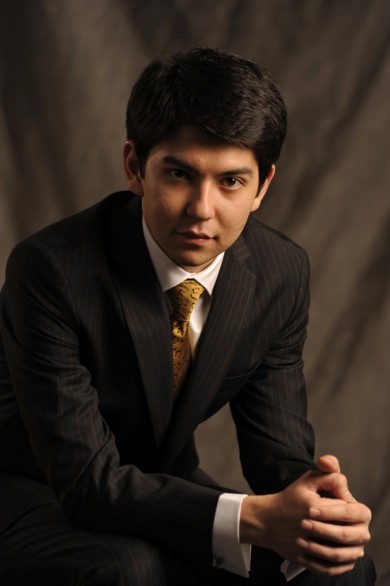Pianist makes impressive debut with Gergiev, Mariinsky Orchestra

Behzod Abduraimov performed Prokofiev with Valery Gergiev and the Mariinsky Orchestra Wednesday night at the Kravis Center in West Palm Beach.
Many second- and third-tier Russian orchestras frequently tour South Florida (even including one of dubious provenance several seasons ago). Their performances are frequently highly variable but when a top-notch Russian ensemble plays here, the difference is immediately palpable. The Mariinsky Orchestra began a two-concert visit Wednesday night with a program of works by Prokofiev and Shostakovich at the Kravis Center in West Palm Beach.
The resident ensemble of the Mariinsky Theater in St. Petersburg, the orchestra performs in various formations as the pit band for opera and ballet performances as well as presenting symphonic programs. Since 1988 Valery Gergiev has commanded the reins of this highly flexible group.
This is an orchestra that can turn on a dime, producing a rich, dark sonority one moment, then sounding brash and raucous the next, matching the musical demands of a highly varied repertoire. While Gergiev’s performances of core nineteenth century Central European scores and the symphonies of Mahler can be eccentric and unsatisfying, he is a superb interpreter of Russian music. The Kravis concert played to the strengths of both orchestra and conductor.
Prokofiev’s Piano Concerto No. 3 in C Major has long been a virtuoso display piece and it proved a perfect introduction for twenty-four year old Behzod Abduraimov. The Tashkent-born, Kansas City-based Abduraimov is a pianistic firebrand. From the piano’s very first entrance, he took off at a fierce speed with steely-fingered power, his keyboard runs clean and accurate. Gergiev’s pitch-perfect accompaniment managed to keep pace with his soloist while displaying the Mariinsky’s deep toned, pointed winds and expressive strings.
Abduraimov captured the irony of the second movement’s principal theme and deftly navigated the curving lines of the ensuing variations. The trumpet solo had just the right touch of harsh sarcasm. The pianist displayed a lighter touch in the softer sections, unfurling a varied color palette. He seesawed smoothly between Prokofiev’s mock elegance and driving momentum.
The wily bassoon solo that opens the final Allegro was splendidly articulated and Abduraimov’s boldly accentuated playing whizzed through the daredevil keyboard challenges. The lush unison strings had a field day with the contrasting lyrical central section, taken at an unusually slow but convincing tempo by Gergiev.
Cheers from the usually sedate Kravis audience brought Abduraimov back for an encore of Liszt’s La Campanella with Gergiev listening on the left side of the stage. The pianist’s bell-like tone and finely shaded dynamics demonstrated that this young pianist is an artist to watch.
Shostakovich’s Symphony No. 8 is not one of the twentieth-century master’s more frequently performed works. A wartime score dating from 1943, it is a sprawling and brooding canvass that lacks the triumphalism of his popular Fifth Symphony or the patriotic fervor of the score’s predecessor, the “Leningrad” Symphony (No. 7).
From the first bars Gergiev established an atmosphere of unrelenting tension and angst, sustaining the musical line impressively throughout the nearly half-hour first movement. The highly disciplined strings’ depth of tone brought strength and pathos to Shostakovich’s dark melodic threads and the high-pitched screams of the winds registered the potent nod to Mahler. Under Gergiev’s tautly controlled direction, the big climaxes were shattering in impact. The cellos and violas’ burnished sound propelled the movement’s final pages.
Gergiev did not attempt to soften the dissonance of the second movement Allegretto, commanding huge blocks of sound at full power in this grim scherzo. The rhythmic urgency of the violins and violas and cohesive brass turned the incisive figurations of the Allegro non troppo into a wild Russian dance. Coming without pause, the Largo is a long, angular passacaglia and the heart and soul of the score. The sonorous horns and strings flawlessly executed the music’s winding arc and Gergiev melded the disparate episodes into a moving threnody. He captured the energy and forward motion of the final Allegretto, the whirling brass fanfares culminating in a final ominous brass and percussion volley.
In the symphony’s austere concluding pages solo violin and bassoon played a seeming caricature of a Russian folk melody as the strings alone faded away, beautifully drawn out by Gergiev. The seasoned teamwork of conductor and orchestra would be hard to match in this score.
Gergiev managed to come up with an encore that would not be an anticlimax after the symphony’s tragic conclusion. The Mariinsky has produced a cycle of successful productions of Wagner’s operas and the soft tones of the Prelude to Act I of Lohengrin displayed the orchestra’s mellow, beautifully blended Wagner sound. Gergiev’s fluid tempo and lyrical flow, underscored by silken violins, matched the music’s serene aura, concluding the concert on an inspired note.
The Mariinsky Orchestra under Valery Gergiev plays Schedrin’s Concerto for Orchestra No. 1 (Naughty Limericks), Mussorgsky’s Pictures at an Exhibition and Tchaikovsky’s Piano Concerto No. 2 with soloist Denis Matsuev 8 p.m. Friday at the Arsht Center in Miami. arshtcenter.org; 305-949-6722.
Posted in Performances
Leave a Comment
Thu Feb 5, 2015
at 12:32 pm
No Comments






